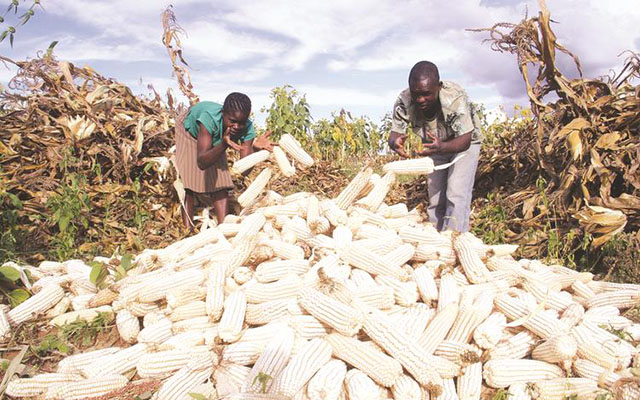Maize production up 280pc: Report

Felex Share Senior Reporter
The 2016/17 agricultural season registered a 280 percent increase in average household maize production from the previous year, the latest Zimbabwe Vulnerability Assessment Committee (ZimVAC) report reveals. The 2017 ZimVAC Rural Livelihoods Assessment Report said as a result of the massive maize production, only one percent of the rural population was food insecure between April and June.
This is an 83 percent reduction compared to the same period last year.
According to the report, Government’s well thought out policies namely Command Agriculture and Presidential Input Scheme coupled with a good rainfall season provided the much needed impetus for an improved rural food security situation.
ZimVAC is a consortium of Government, United Nations agencies, non-governmental organisations and other international organisations.
The committee’s assessments have become key reference documents for humanitarian and development intervention programming by Government and development partners.
Reads the report: “Nationally, there was a 266 percent increase in average household cereal production, 280 percent increase in average household maize production and 157 percent increase in average household small grains production from last season.
“Considering the high household cereal production and findings from previous ZimVAC assessments, which indicated that most households use improper facilities to store their grain, there is need to foster good post-harvest management to minimise potentially high post-harvest losses. The average household production was in Mashonaland West (739,2kg) and the least in Matabeleland South (174,5kg). Masvingo had the highest increase from 42,3kg to 356kg and Mashonaland West had the least increase from 397,6kg to 739,2kg.”
Over 80 percent of households in all the provinces planted maize.
On food insecurity, the report indicated that the numbers of insecure households had significantly decreased.
“Rural food insecurity for the period April to June 2017 was estimated at one percent and is projected to reach 11 percent during the peak hunger period (January to March 2018),” reads the report.
“As expected, there is a progressive increase in the proportion of food insecure households as the consumption year progresses towards the peak hunger period. About 1,1 million rural people are estimated to be food insecure during the peak hunger season.”
About 4,1 million people were food insecure during the peak hunger season last year.
Provinces with areas expected to be food insecure during the 2017/18 consumption year include Matabeleland North, Matabeleland South and Midlands.
The report indicated that maize, groundnuts and cowpeas were the most common planted crops by households.
“The proportion of households growing small grains remains low despite all the efforts and rhetoric to promote the growing of these crops,” reads the report.
“There was a general increase in the proportion of households that planted all crops. The greatest increase was in the proportion of households that grew tobacco and cotton due to support these crops got from the private sector and Government respectively. As in previous seasons, Matabeleland North, Matabeleland South and Masvingo had high proportion of households which grew small grains in the 2016/2017 agricultural season.”
The report notes the need to capacitate agricultural extension services.
“The proportion of households receiving agricultural training has remained relatively low for the past three years at 38 percent in 2014/15, 35 percent in 2015/16 and 34 percent in 2016/17,” reads the report.
“Government was reported as the most common provider of crop extension services in all provinces (88 percent) followed by NGOs (7 percent).”
Other support services were offered by lead farmers.
Public Service, Labour and Social Welfare Minister Prisca Mupfumira yesterday while her ministry had welcomed the assessment report, social welfare officials were working with provincial administrators to update their registers.
This, she said, would ensure all deserving people got necessary assistance.
“We have received the report and I have presented it to Cabinet for approval, dissemination and use by all stakeholders,” she said.
“Our teams will go out in provinces and make their quantifications also. To sum it up, preparations are underway to commence the food deficit mitigation programme for vulnerable households for the period 2017 to 2018. This week there was a workshop that brought together stakeholders to prepare for the implementation of the programme.”
ZimVAC reports provide updates on pertinent rural livelihoods issues such as education, health, food and income sources, income levels, food security among others.
This year’s report was prepared using data collected from 11 858 households, 4 422 children and 1 170 community group discussions from districts in the country’s eight rural provinces.









Comments